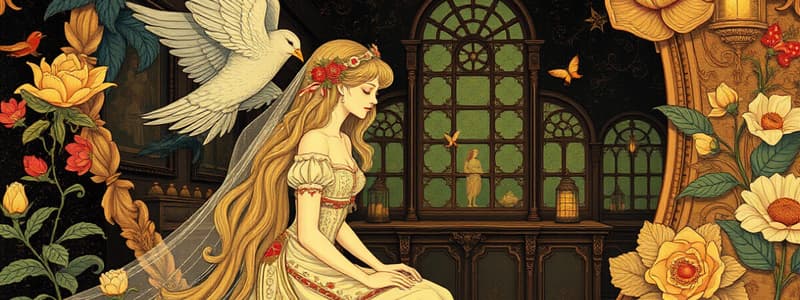Podcast
Questions and Answers
What period does Contemporary Art primarily refer to?
What period does Contemporary Art primarily refer to?
- 1900-1960
- 1960-now (correct)
- 1970-2020
- 1800-1860
Which of the following is NOT considered a type of Visual Art?
Which of the following is NOT considered a type of Visual Art?
- Drawing
- Fashion Design (correct)
- Photography
- Sculpture
What defines Applied Art?
What defines Applied Art?
- Art that represents abstract ideas without tangible forms.
- Art combined with practical applications and utility. (correct)
- Art that is purely decorative and lacks functionality.
- Art created solely for performance in front of an audience.
Which art form involves the representation of objects through selected sequences of movement?
Which art form involves the representation of objects through selected sequences of movement?
Which of the following is an example of a decorative art that often serves a practical purpose?
Which of the following is an example of a decorative art that often serves a practical purpose?
What is the primary purpose of practical (utilitarian) art?
What is the primary purpose of practical (utilitarian) art?
Which type of art includes activities like flower arrangement and dress making?
Which type of art includes activities like flower arrangement and dress making?
What distinguishes prose from poetry?
What distinguishes prose from poetry?
Metrical romance is primarily characterized by which of the following themes?
Metrical romance is primarily characterized by which of the following themes?
Which of the following is NOT included in the definition of commercial art?
Which of the following is NOT included in the definition of commercial art?
Study Notes
What is Art?
- Art encompasses creative activities such as painting, music, literature, and dance.
- Functions as a reflection of society's events and emotions, particularly in contemporary art.
Contemporary Arts (1960-Present)
- Emerged in the late 1960s, focusing on current societal issues.
- Characterized by cultural diversity and a technology-driven environment.
- Social realism movement gained momentum during this period.
Modern Art (1860-1960)
- Includes diverse styles and innovative approaches to artistic expression.
Visual Art
- Art form that represents the artist's ideas through various mediums.
- Drawing employs tools like pencil and charcoal to depict forms.
- Painting involves applying color to surfaces for aesthetic or protective purposes.
- Sculpture is a three-dimensional art using materials such as clay, stone, and wood.
- Calligraphy focuses on visually appealing writing styles.
- Photography captures images on film, blending art with technology.
Applied Art
- Defined by practical applications alongside aesthetic aspects.
- Architecture involves designing and constructing buildings with functionality and aesthetics.
- Fashion design is the creation of clothing that balances beauty and utility.
- Pottery combines utilitarian objects with decorative elements.
- Jewelry design crafts intricate ornaments from various materials.
- Interior design strategically plans spaces for aesthetic appeal and function.
Performing Art
- Engages audiences through live performance formats including drama, music, and dance.
- Dance consists of organized movements for artistic expression.
- Music merges vocal and instrumental elements to form compositions.
- Theater and film present narratives that entertain and captivate viewers.
- Literature employs language creatively to convey ideas and emotions.
Practical (Utilitarian) Art
- Focuses on functional art that also possesses decorative qualities.
Industrial Arts
- Transforms raw materials into significant products, including craftsmanship in various domains like pottery and metalwork.
Applied/Household Art
- Encompasses domestic activities such as flower arrangement, dressmaking, and cooking.
Civic Art
- Involves urban planning and beautification efforts to enhance community life.
Commercial Art
- Encompasses advertising methodologies including billboards, posters, and graphic design.
Graphic Art
- Involves printed materials produced from various relief techniques.
Agriculture Art
- Pertains to agricultural practices such as crop production and animal husbandry.
Business Art
- Includes practical skills in merchandising, accounting, and administrative tasks.
Fishery Art
- Focuses on fishing techniques and practices for sustainability.
Literature
- Poetry employs symbolic language to express emotions.
- Prose presents storytelling in informative and persuasive forms, such as essays.
Spanish Colonial Tradition
- Metrical romance explores themes of chivalry, folklore, and religion.
- Pasyon recounts the life of Jesus Christ through a structured poetic form.
Forms of Contemporary Prose in the Philippines
- Folk narratives tell stories from community traditions, blending fact and fiction.
- Myths offer explanations of origins and early inhabitants.
- Legends recount events involving notable figures, often entwined with miraculous occurrences.
Types of Contemporary Prose
- Folktales span various genres: animal fables, magic tales, and humorous stories.
- Essays present insights through descriptive and narrative styles.
- Novels are complex narratives grounded in creativity.
- Short stories are concise narratives encompassing diverse themes.
- Komiks combine visual art with storytelling through illustrated frames.
Music Elements
- Melody: Sequence of notes with varied pitches.
- Rhythm: Includes tempo, meter, and rhythmic patterns.
- Harmony: Blend of different tones sung or played together.
- Texture: Interaction of melodic and harmonic lines.
- Dynamics: Variation in loudness and softness.
- Timbre: Unique quality of sound distinguishing different instruments.
- Form: Structure in which musical elements are organized.
National Artists of the Philippines
- Esteemed title awarded to individuals with profound contributions to arts and culture.
- Recognizes significant impacts on the artistic heritage of the Philippines.
- Juan Nakpil (1973): Noted for modern Philippine architecture, including the design of crucial structures like the Quiapo Church's bell tower.
Studying That Suits You
Use AI to generate personalized quizzes and flashcards to suit your learning preferences.
Description
This quiz explores the evolution of contemporary art from the 1960s to the present. It focuses on how this art form reflects modern societal events and cultural diversity. Test your knowledge on key movements and influential artists of this vibrant period in art history.




